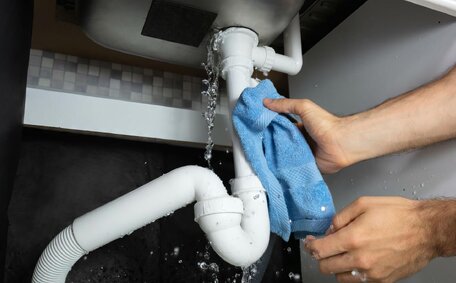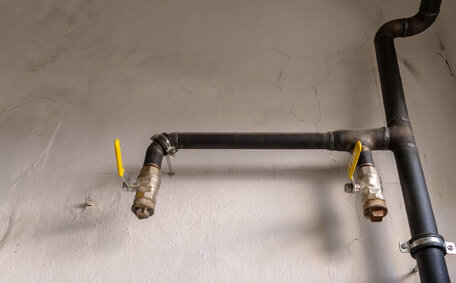What causes a shower drain to become blocked?
Several factors commonly cause shower drains to clog over time. Common causes of a drain clog include hair, soap residue, and debris quickly forming blockages. As debris gradually gathers, it can halt the water flow in your pipes, leading to clogs.
Hard water deposits and small items, such as hair clips, can also clog drains, underscoring the importance of learning effective unblocking techniques. Tree roots can also invade and damage underground plumbing pipes, where a blocked shower drain can result.
Regularly employing drain cleaning practices and preventive methods can help you avoid many blockages. However, even meticulous maintenance can’t prevent all obstructions, so knowing how to unclog your shower drain is crucial.
Identifying signs of a blocked shower drain
There are several clear signs that indicate your shower drain is blocked. The most obvious sign of a blocked shower is water pooling in the shower tray instead of draining away quickly. You may discern gurgling noises, a signal that buildup within might cause blocked flow or an unpleasant sewer odour.
Additional signs that prompt steps to unblock shower drain include noticing water draining slower than usual, or ceasing to drain entirely. Your shower floor may feel unusually slippery from standing water residue. Dripping water still around the shower drain despite the shower being off can indicate a more grave underlying issue, such as a cracked pipe.
Being skilled in noticing problems and taking action early on increases the success rate to fix your drainage issues for how clear blocked passages before major blockages occur. Catching problems when they first arise can also prevent extensive plumbing repairs down the line, saving you money and hassle.
Trying a plunger to dislodge a clog
With the right technique, a plunger can deal with blocked shower drains effectively, clearing the passage for water to flow.
Begin by positioning the plunger over the drain to create a seal after removing the plug. Fill the tray of the drain shower with a few inches of water then plunge vigorously up and down, moving water down drain in a fast, forceful push-pull motion.
The suction pressure can remove the blockage drain, creating an unimpeded path for water down drain so it can drain away freely again.
After use, clean the plunger and rinse the drain thoroughly.
Using a large, heavy-duty drain plunger specifically designed for showers can yield better results than a standard toilet plunger for clogged drains. Ensure you don’t scratch your shower basin with the plunger.
Pouring boiling water down the drain
Pouring boiling water down your shower drain, with protective rubber gloves, can help melt and remove build-up of hair, soap scum, oil, and other residues. The strong heat aids in melting congealed grease, which is a safeguard against a significant drain clog, while the power of the flowing liquid helps in ejecting waste down the pipe.
To effectively address long hair blockages, boil a full kettle and pour it carefully down the drain to tackle accumulations. Direct the stream of boiling water directly down your shower drain to target the clog. Refill and execute again several times, allocating minutes before each pour for the hot water to act upon dissolving the blockage.
Take care to prevent scalding and protect your bathroom fixtures. Wear shoes and gloves for protection and use a towel to absorb any splashing water that could damage your floor. Also be mindful to not surpass the heat capacity of your pipes, which could cause a shower drain blockage due to pipe damage.
Using baking soda and vinegar
Baking soda and vinegar combine to form an efficient home solution for breaking up small clogs. Both ingredients are very affordable, non-toxic, and commonly found in most kitchen pantries.
To use this homemade solution, remove the drain cover and pour a cup of baking soda down the drain. The chemical reaction between baking soda (a base) and vinegar (an acid) produces gas bubbles that can dislodge grime, hair, and other gunk stuck to pipe walls.
Following the baking soda, add 1 cup of white vinegar and let the mixture fizz for 5-10 minutes.
Then, flush with hot tap water for a minute to wash out the remnants, following up on the vinegar and baking soda reaction. You might have to make sure to repeat the procedure a few times for steadfast shower drain clogs. Always conclude by flowing ample cold water to ensure any resolved drain blockage is thoroughly flushed away.
Removing hair and debris by hand
Before removing visible obstructions, take off the drain cover and protect your hands with gloves. Use tweezers or a straightened wire hanger to meticulously remove hair, soap deposits, and other reachable debris.
Avoid sharp tools that could scratch the drain. Take care not to push debris further down the pipe. Remove all extracted items right away so they don’t fall back in.
Finish by circulating hot water for a minute to assist in expelling particles, a preventative measure against cause blocked shower situations.
While helpful for surface issues, resolving deep-set obstructions in most cases of a blocked shower drain can take more intensive measures.
Using a drain snake/auger
A drain auger, also known as a plumber’s snake, is an effective tool proven to dislodge more resistant clogs from deeper within the pipes. Start by fully removing the drain cover then slowly feed the rotating drill-shaped end of the snake down the opening while gently pushing and turning the handle.
Continue feeding the snake into the drain, turning the handle to reach and clear the clog. The snake’s metal corkscrew tip grips and removes hair and debris, dislodging clogs when retracted. Once the snake moves freely, retrieve it carefully to avoid scratching the pipe walls.
Be cautious not to push the blockage further into the pipes, complicating the issue.
Drain snakes come in various lengths, and you need one that’s long enough to fix clogged shower drain areas beyond the immediate trap. Getting professional help to fix your plumbing issues is advised if you are pondering how fix the obstruction but DIY attempts fail to clear it fully.
Trying chemical drain cleaners
Chemical drain cleaners, sometimes a final resort, can dissolve clogs and are available at hardware stores. However, they can severely damage pipes or be hazardous if mishandled. Only use drain cleaners as an absolute last resort after trying safer methods.
If you decide to resort to chemical solutions, you can use an enzyme-based or microbial product designed specifically for showers and sinks. Avoid anything containing corrosive ingredients like sulfuric acid or lye which corrode pipes. Strictly follow all manufacturer safety directions and never mix cleaners.
Wear protective gloves and goggles when pouring to avoid chemical burns. Only apply cleaners to a completely cool drain. Apply cleaners only to a cool drain and wait the suggested time before running water to flush away the dissolved matter. Properly dispose of any leftover cleaner.
While commercial drain cleaners may tackle reasons why your shower is not draining, like hair and soap buildup, they come with substantial risks like toxic fumes. Repeated use also kills beneficial bacteria keeping drains clear. For many clogs, safer DIY methods to unblock shower drains or calling a professional plumber is the best solution.
Recognizing when professional help is needed
While DIY approaches can do wonders for minor clogs, a persistent clogged issue may necessitate the expertise of a professional plumber. If your attempts to unblock your shower drain have failed, it’s a sign you might ponder what to do when professional equipment or expertise is needed.
Should you encounter any of these concerning signals, get touch with Eastwood Plumbing:
- Water continues backing up despite your efforts
- Clogs reappear shortly after you clear them
- You smell sewer gas or see water damage
- Multiple fixtures are clogged, indicating a main line issue
- A drain snake cannot reach or dislodge the clog
Adhering to our guide to dealing with resilient obstructions ensures that your attempts are as fruitful as possible, even before seeking professional help. We inspect drain lines with cameras to locate troublesome clogs and use advanced methods like hydro-jetting. We can also detect and remove tree roots compromising your pipes.
Don’t wait until you have extensive water damage or backflow flooding other areas of your home. Contact Eastwood Plumbing today to ensure your water supply is functioning smoothly. Call 1300 349 338 or email jobs@eastwoodplumbingservices.com.au and we’ll help restore proper water drainage quickly and efficiently.
Preventing future clogs with regular maintenance
Instituting regular maintenance is the key to keep your bathroom clear of obstructed drains. Simple preventative steps done consistently can stop most clogs before they occur.
Weekly, extract the cover and utilise cleaning vinegar in tandem with baking soda to purge collected hair.
A mixture of baking soda followed by hot water can dissolve soap remnants and residue.
Alongside weekly cleaning, perform a thorough monthly descaling of the shower drain:
- Remove the drain cover and extract any visible debris by hand.
- Pour half a cup of baking soda into the drain, followed swiftly by a full cup of vinegar. Let the mixture fizz for 10 minutes.
- Boil a full kettle of water then slowly pour down the drain to flush away your clogged shower drain residue and buildup.
- Finish by running cold water for a minute to cool pipes.
Additionally, preventing debris from entering the drain is crucial. Use drain catchers and screens to trap hair and debris. Avoid letting things like soap bars, bottles or razors fall into the drain.
Consistent weekly and monthly maintenance can ward off debris buildup and avert expensive plumbing repairs.






